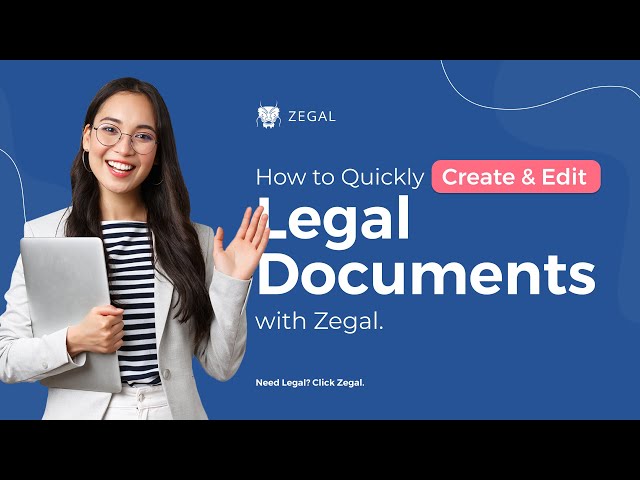How to generate a Notice for Infringement of Rights
In essence, a Notice for Infringement of Rights is a warning letter. Generally, you send one to an individual or business to stop a breach or any illegal activity that violates your rights (“cease”) and not to restart it (“desist”). Typically, the letter warns that if the recipient does not stop the specified breach or illegal activity –or take certain actions by the deadlines set in the letter– you may take legal action against the recipient.
What is a Notice for Infringement of Rights?
A Notice for Infringement of Rights is a request asking the recipient to refrain from doing certain acts that violate your rights.
The letter delivers a clear warning that if the illegal activity doesn’t stop immediately, legal action may follow to make it stop. This may also include a demand for an appropriate penalty if the letter isn’t taken seriously.
Sending a Notice for Infringement of Rights does not mean you have initiated legal action. But, it means you are sending a warning that legal action may be taken if the illegal activity/ violation is not stopped.
When do you use one?
A Notice for Infringement of Rights can be used in a situation where your rights have been violated or denied. You use one when you need to send a clear warning to the person who has done so to stop or face legal action. Popular cases include:
- Trademark, copyright, or patent infringement. Where someone copies, misuses or takes illegal benefit from a trademark or copyright or patented product or asset. This includes violations of copyright laws and intellectual property laws.
- Breach of contract. When someone does not fulfill the obligations assigned to that person under a contract. Or, acts against the terms and conditions agreed under a contract.
- Harassment. If a person harasses, intimidates, or threatens another.
- Debt collection. When a debt collector or a debt collection agency makes excessive phone calls or contact approaches that are tantamount to harassment.
- Defamation (slander and libel). Applies when a person does something that causes detriment to the reputation of another.
How does this letter work?
A Notice for Infringement of Rights works as an effective tool to:
- Identify the illegal activity that has violated your rights and the person conducting such activity;
- Requires that person to immediately stop the activity or violation; and
- Warn the person that if they do not immediately stop such activity or violation, legal action may follow.
What does violation of rights mean?
Essentially, violation of rights occurs when a person fails to perform an action (e.g. making payments under a contract). Or, does an action that he is not supposed to do (e.g. copyright infringement, defamation).
In a nutshell, whenever you are denied something that you have a right to or whenever something that is rightfully yours has been taken or used without your permission, your rights have been violated. For example:
- Non-payment of service fee (breach of contractual obligation). Your right to get the service fee under the contract has been violated.
- Use of copyrighted content without permission (Copyright infringement). Something that is rightfully yours has been used without your permission.
- Fake news about your product circulated on social media (Defamation). Your right to protect your reputation has been violated.
- Disclosure of confidential information (breach of contractual obligation). Another party has violated the terms of a non-disclosure agreement.
To whom can I send a Notice for Infringement of Rights?
Basically, you can send the letter to anyone who has committed a breach or violation. This can be an individual or an entity. Importantly, you just need to ensure that the correct name and address are mentioned in the letter.
How do I serve a Notice for Infringement of Rights?
Usually, you send a Notice for Infringement of Rights by registered mail or certified mail. Specifically, you do this so you get a delivery receipt (or return receipt). Then, you can use this receipt as proof should you need to. Additionally, you gave an opportunity to the defaulting person to stop before initiating any legal action. Thus, certified mail is considered a prudent approach. It helps create evidence to produce in legal proceedings in court if you need to take legal action.
Additionally, you can serve the letter via email or fax, or through an attorney. In all, these means of serving the letter, evidence, or trail of delivery will confirm the letter is with the recipient.
Do I need to hire an attorney to serve this letter?
No, you don’t necessarily need to hire an attorney to serve a Notice for Infringement of Rights. But, you can have an attorney review the contents of the letter. This is helpful to identify whether the activity you are claiming to be illegal is actually illegal or not. Also, whether your rights have definitely been violated or not.
What do I need to put into my Notice for Infringement of Rights?
- Name of the person who has violated your rights (the recipient)
- Address of the recipient
- The rights that were violated
- What is the act of the recipient that has violated the rights?
- Damage has been caused due to the violation of rights?
- The deadline the recipient must stop the activity by
- The result or penalty to the recipient if they do not stop such activity
- Date of notice
What happens after you serve this letter?
Typically, after serving a Notice for Infringement of Rights, the recipient will stop the illegal activity in the letter. Usually, the recipient will reciprocate with a reply letter of clarification and assurance that the illegal activity will stop. In cases where the illegal activity does not stop within the given deadline in the letter, the sender initiates a legal notice that may include demands for damages and injunctive relief.
Is a Notice for Infringement of Rights a legal notice?
A Notice for Infringement of Rights is not a legal notice and it is not legally enforceable. But, it is an effective tool to protect yourself or your business. Basically, the letter is a simple warning to the defaulting party that you may take legal action if the breach or non-tolerable activity doesn’t stop.
Essentially, you don’t need to be a lawyer (or hire one) to send someone a Notice for Infringement of Rights. Hopefully, by sending a cease and desist notice, you will successfully convince or intimidate your harasser or infringer to stop their behavior without a lawsuit. In all, this will save you time, money, and effort.
Is a Notice for Infringement of Rights the same as a Cease and Desist Order?
No. A Notice for Infringement of Rights is an effective tool to serve as a warning to someone to stop engaging in illegal activity. But, it is not a legal document. Either, an individual or his attorney may send one.
A cease and desist order is also known as an injunction or restraining order. This is an official legally binding document. Only a court or government agency can issue a cease and desist order. It requires someone to stop doing a certain behavior. And, if they fail to do so, they may be found in contempt of court and face penalties. These include fines or jail time.
Essentially, if you want to get a cease and desist order, you must file a lawsuit or other paperwork with the court. Then, after you file the paperwork, the other side will have an opportunity to respond. Finally, the court will decide on the matter based on all of the facts presented.
You Might Also Like
Along with this document, make sure you see these other templates in our library:
- Shareholder Agreement
- Cease and Desist Letter
- Employee Option Repurchase Agreement
- Share Appreciation Rights Plan
- Share Option Plan
Stay compliant with the Zegal template library
Zegal legal template are meticulously crafted with the precision of AI and the expertise of seasoned human lawyers, providing a unique blend of speed and reliability.
You can trust that Zegal agreements are legally sound and fully compliant with current regulations.
Whether you're a startup, SME, or a larger enterprise, Zegal contract management will automate and speed up your legal processes.
Using Zegal will reduce risk, save money, and improve efficiency. Let us take care of the paperwork so you can focus on running your business.
Don’t compromise on speed or compliance. Stay secure, compliant, and efficient with Zegal.





